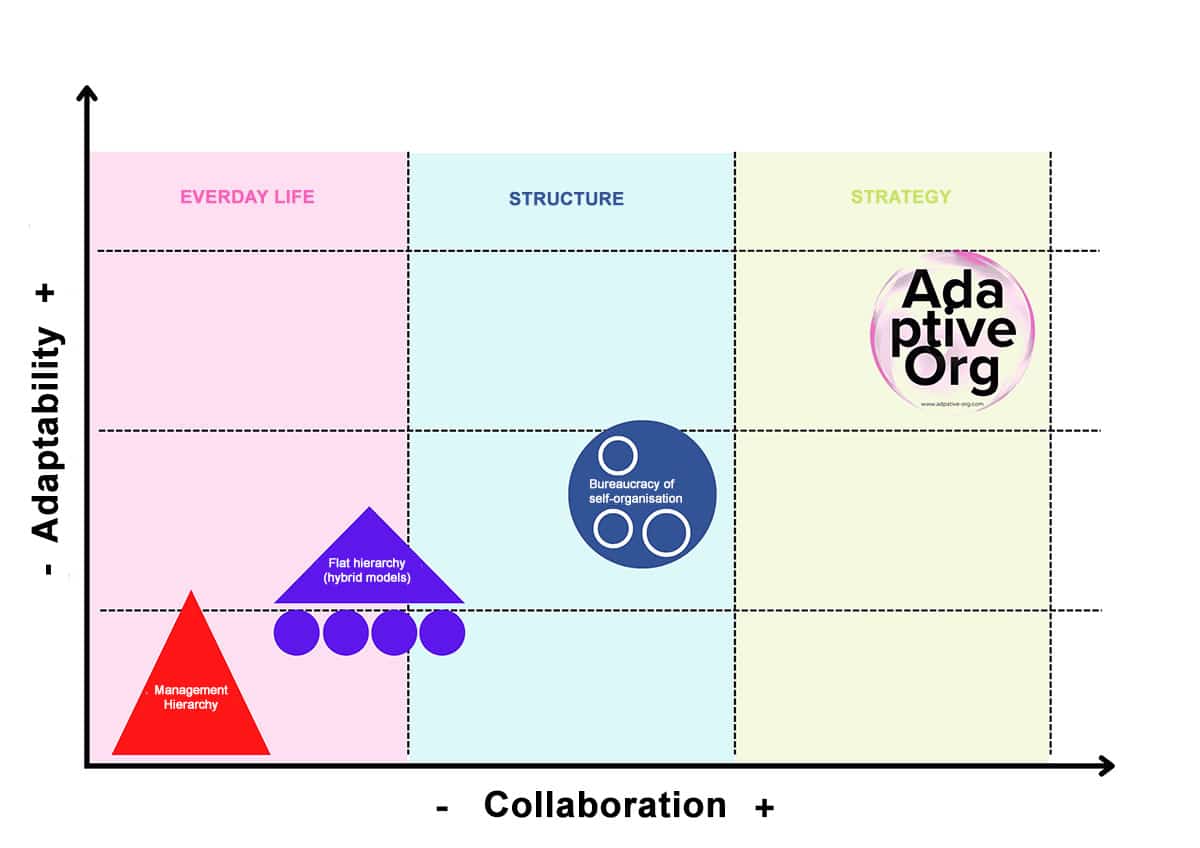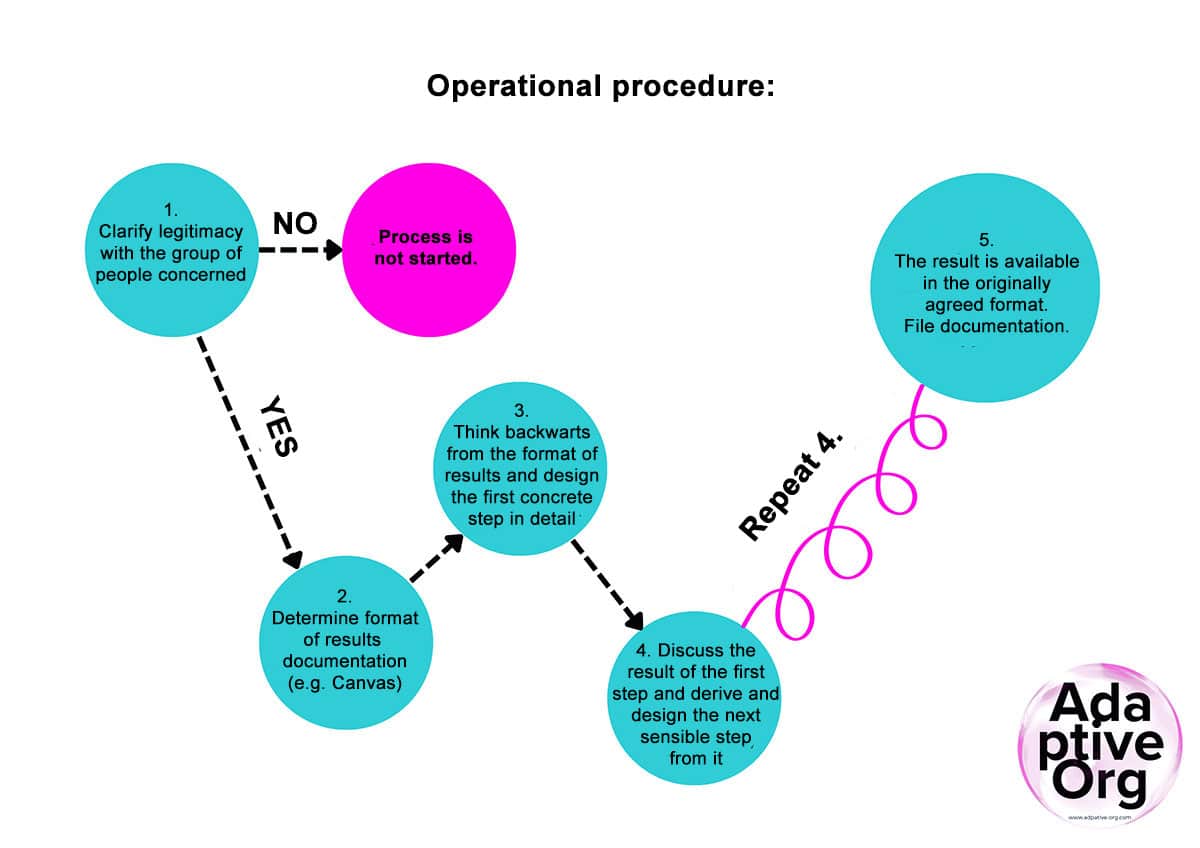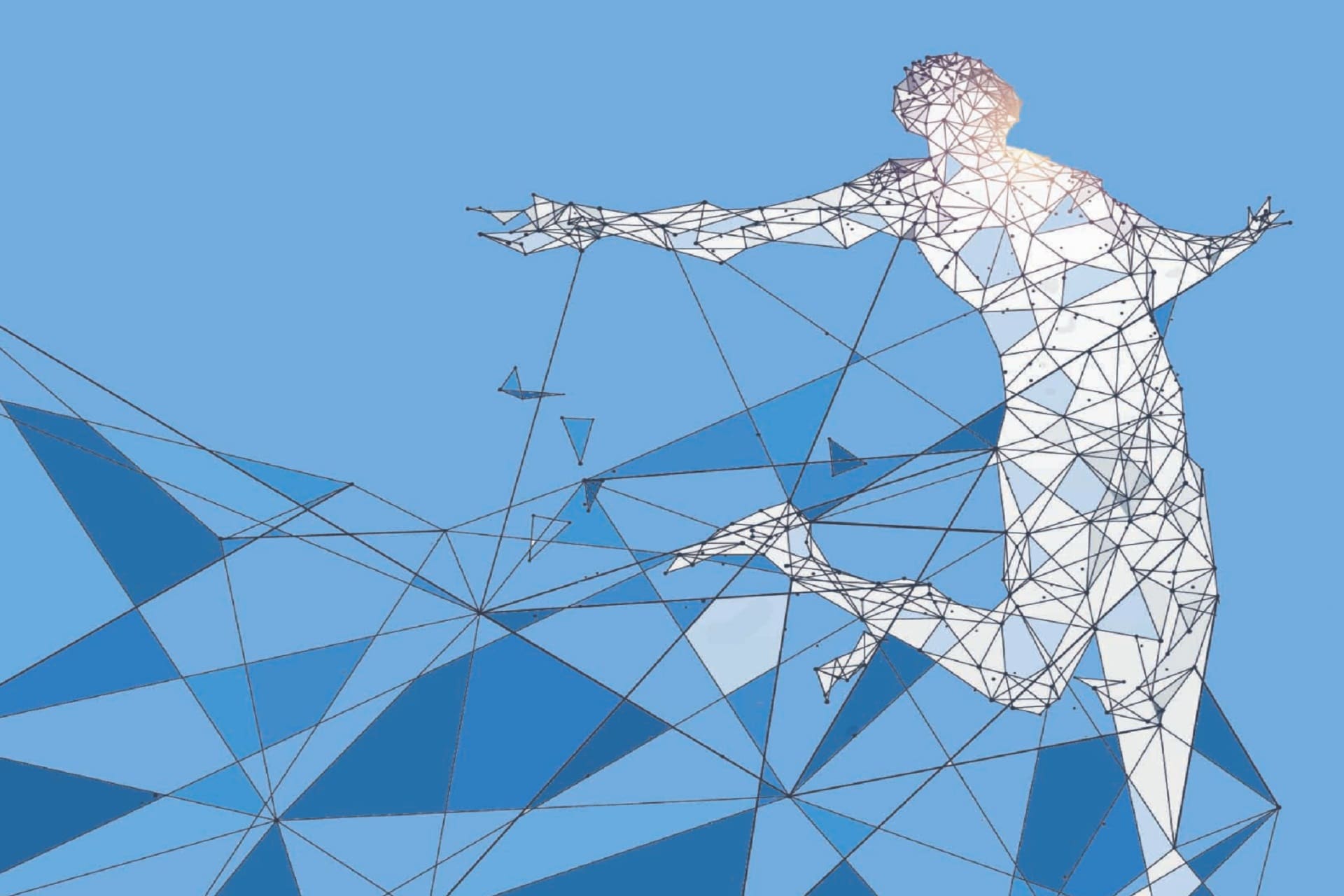Cooperation and collaboration in #AdaptiveOrgs
#AdaptiveOrg – the Swiss army knife for small and medium-sized enterprises
Do you know MacGyver? In the Hollywood series of the same name, which started in 1985, MacGyver was a secret agent who mastered every challenge with his Swiss Army knife. His renunciation of violence and firearms was a pleasant contrast to the multiple action-packed Hollywood series of that time and today. In a way, he was the living antithesis of competitive behaviour that accepted collateral damage and endangered people’s health in order to achieve goals.
Unfortunately, in today’s business world, which is based on hierarchical, competitive behaviour, collateral damage is not uncommon. In many television series or feature films, it is the main character who uses the latest technical advances to protect an existing system and, if necessary, go over dead bodies. In companies, it is managers who assert the supposed interests of their own organisation against competitors and sometimes even their own employees. For example, they introduce new technologies for the purpose of digitalisation, and employees who critically question these technologies often have a hard time.
For me, MacGyver and his pocket knife symbolise the non-violent alternative of representing the interests of a company. What MacGyver was for Hollywood, the #AdaptiveOrg is for the business world today.
Cooperation and collaboration as the means of choice
With #AdaptiveOrg, small and medium-sized enterprises are taking an alternative path that consistently relies on cooperation and collaboration. Many organisations today already favour genuine togetherness instead of internal competition. In everyday life and in product development, for example, cooperation takes place at team level. Unfortunately, this cooperation still too often ends at the control or strategy level, and the management system – even in companies with flat hierarchies, and in hybrid/agile or self-organised organisations – remains in competition mode, which also has consequences for the adaptability of the company.
What is the problem with competition systems?
Let’s take a look at different aspects of competition:
Losers: In competition, as we know from sports, there is always a loser. In our companies, these are the employees and employed managers. The majority of them did not make it to the (next) promotion. The salary increase was rejected or the performance was judged poor in the appraisal interview. Although there is pain compensation in the form of wages and salaries, this does not make it any better, especially since losers are produced year after year.
Health: An essential difference between a company and, for example, a football match is that the latter ends after 90 minutes. Competition in our companies does not take a break. No sooner are the monthly results known than the quarterly results are announced, and so on. The pressure never ends. Unsurprisingly, this leads to massive health risks. Today better known as burnout, depression or later as dementia.
Demarcation: You probably know this from your circle of acquaintances. Before the election, there is a heated discussion about which party has the best programme. Yellow, green, red – they are in competition. And the voters practise demarcating the colours. Everyone takes a side. Parties promote this through identity-creating communication. We know the result. Although we have more than enough urgent issues on the agenda, defending one’s own convictions comes to the fore. The fact that we have common goals, such as getting a grip on climate change, degenerates into background noise.
Adaptability: Internal competition steers the focus in the wrong direction. According to the motto, two fight and the third is happy. In our case, the third party is the competitor in the market. Internal position battles steal the attention of customers. Instead of passing on observations from the market, employees only tell what their superiors want to hear in order to look good in competition. As a result, vital impulses for necessary changes/adjustments are lost for the company.
These are some of the most important negative aspects of competitive systems, although I do not want to condemn all competition in principle. For example, I am passionate about tennis and I want to win. I enjoy challenging myself and competing with my opponent. But the most important thing for me is to have a good relationship with my opponent after the match. No victory is worth losing sight of our common goal, the joy of sport. There is also a sensible way of dealing with competition in companies. But that is on another sheet of paper. Let us now turn to the alternative to the scenarios described.
The #AdaptiveOrg – a solution for a better (business) world?
Certainly, an adaptive organisation can contribute to a better (business) world, but taken as a whole, it is only one piece of the puzzle. We will need many pieces of the puzzle to bring about a turnaround in our (business) world on a large scale.
For small and medium-sized enterprises (SMEs), #AdaptiveOrg is a really good start into a cooperative future.
It aims to develop a healthy and equal community.
It pushes competition from the inside of the company to the outside boundaries to the market & competition. This creates a high level of commitment, adaptability and a sense for overarching challenges such as climate and society. And of course economic success.
I would like to refer to a study by the Corporate Democrats around Andreas Zeuch¹. It comes to the clear conclusion that cooperation/participation in organisations fuels their sustainability efforts and at the same time ensures (green) competitive advantages.
Let’s briefly turn our gaze to the three problems addressed in competitive systems before we continue with the “how” of #AdaptiveOrg:
Losers: There are no losers in the #AdaptiveOrg. Simply because there are no formal managers and thus no competition for positions. Salary increases and staff appraisals become a team affair. There are no 1:1 conversations where one person judges another.
Health: Stress in collaborative companies is significantly lower. Simply because people rely on their colleagues. Relationships at eye level release the pressure of having to please someone. It is clear to everyone that we are not enemies, but accomplices in the survival of the common enterprise.
Demarcation: It always takes place. That is why it is important to make sure that it does not get out of hand. As a brand in external presentation, identity is a good thing. But #AdaptiveOrgs avoid strengthening it too much internally. Instead of convincing individuals with purpose, vision, mission and values that they are in the right company, they offer other possibilities of identification, such as the factual value proposition to the customer.
Adaptability: In collaborative environments there are no unnecessary distractions. Impulses from the market are picked up and perceived directly by the people. They have the opportunity to make adjustments without having to wait for permission from superiors. The group of people affected, who are involved in finding solutions, serves as risk management. Through their concerns and resistance, the adaptation proposal is put through its paces. In this way, collaboration uses critical thinking and creativity for the benefit of the organisation, and thus for the benefit of all.
How does cooperation succeed in #AdaptiveOrgs?
#AdaptiveOrgs follow a simple approach: the workforce receives an offer to solve challenges that affect more than one team in a different way with the support of so-called catalysts. If a group decides to accept an offer, the first step is to define the group of people affected. These people are then invited to form a temporary team that takes on the task of solving the issue. There are two options here:
- If not enough people come forward for a defined issue, this is an indication that there is no urgency in the group of people concerned to work on it. Without urgency, there is no reason to start the process of developing a solution in the first place.
- If a sufficient number of people (a so-called active minority) are interested in the issue, then the solution process begins.
The important thing is: people who were invited but declined the invitation tacitly accept the outcome that their colleagues are working on. This principle must be known to the group of people involved. With this trick, catalysts achieve the necessary consistency in group decision-making processes and the feared “whining”, as you may know it from grassroots democratic approaches, does not occur.
The team then starts designing the solution process with the help of the catalysts. The following aspects are important:
- All participants have equal rights. Workshops & Co. are designed in such a way that perspectives and speaking time are distributed. The common goal is always brought to the fore. Diversity flourishes. Quiet people get a voice so that the usual suspects (loud dominant people) do not always prevail.
- The design is done backwards from the documentation of results. As soon as it is clear in which format the result will be documented (e.g. a canvas), the design is started from there in the opposite direction. Only one step is worked on at a time. Only when this step has been completed and the results are known, is the next step tackled iteratively. In this way, we prevent preconceived methods or frameworks from dominating. Instead, the focus remains on the next sensible step in order to achieve the best results for the group or the organisation.
The operational process is thus as follows:
Responsibility and self-care of the #AdaptiveOrg catalysts
The #AdaptiveOrg catalysts ensure with their design that the perspective of the organisation is in the foreground. If the company is doing well, the individuals are also doing well. Through this focus, the classic leadership task of having the company’s interests in mind is distributed to the entire group.
The catalysts’ responsibility begins and ends with process support. They are not decision-makers and stay out of discussions. They have done a good job if the group they accompany learns about the agreed topic. Ideally, resistance from the group is skilfully used to improve the solution in order to reach a satisfactory result. Speed, by the way, is not a quality criterion, nor is pushing through methods or approaches.
Self-care is a critical aspect for #AdaptiveOrg catalysts. There is some risk that catalysts forget and lose themselves in the work they do for their company. This makes it all the more important that they take care of themselves appropriately and, if necessary, point it out to each other should signs of overload appear. For example, it is not advisable to accompany a workshop if an emotionally challenging conversation has taken place hours before.
Conclusion
There are challenges that can hardly be mastered with classical management in traditional competitive systems. More and more companies are therefore looking for ways to optimise their existing systems. But there are indications that this is not enough. Already today, there is an adaptive organisation somewhere in the world in practically every industry that focuses on genuine cooperation. What they have in common is that they successfully deal with dynamically occurring changes that make it virtually impossible for traditional organisations to keep up.
#AdaptiveOrgs solve challenges through cooperation and collaboration. Some companies have successfully sailed through existential crises and renewed their business model. Others solve pragmatic issues such as office relocation or a new home office and working time arrangement. The increasing adaptability of companies is striking. At the same time, the stress of those involved is decreasing and the relationships between employees are improving. It is nice to see when a trainee makes a joke at the expense of the managing director and everyone present laughs heartily about it together. At the end of the day, it’s all about achieving a positive impact on economic success as a community. And this is what small and medium-sized enterprises can achieve by becoming #AdaptiveOrgs.
Notes:
The article describes the core operational process of #AdaptiveOrg and the associated role of the catalyst. There are also some elements such as reporting, thinking tools and thought models that round off the approach to a Swiss army knife for SMEs. If you are interested in learning more, then it is worth attending an #AdaptiveOrg Discovery Session. For dates and more information in German, visit www.adaptive-org.com.
[1] Corporate Democrats: Organisational Sustainability: More Successful with Participation (in German)
If you like the post or want to discuss it, feel free to share it with your network.
Joan Hinterauer has published three more posts on the t2informatik Blog:

Joan Hinterauer
Joan Hinterauer loves to break new ground and dive deep into the unknown surroundings. After 15 years of typical working life and up the career ladder to managing director, he knows the laws of the business world. For 3 years he has been breathing air into New Work as an absolute career changer in order to make it available to his customers as concentrated experience knowledge. As a transformation catalyst, he accompanies decision-makers in the development of a sustainable attitude for the digital age in the context of the perspective journey for medium-sized businesses. In addition, he advises companies with innovative thinking tools on the way to self-controlling network organisation and the sensible use of agile concepts and methods. In a wide variety of collaborations, he is a role model for the network idea and knows the challenges like the back of his hand. Joan Hinterauer is always available for extraordinary actions and likes to refute statements as to why something should not be possible.




